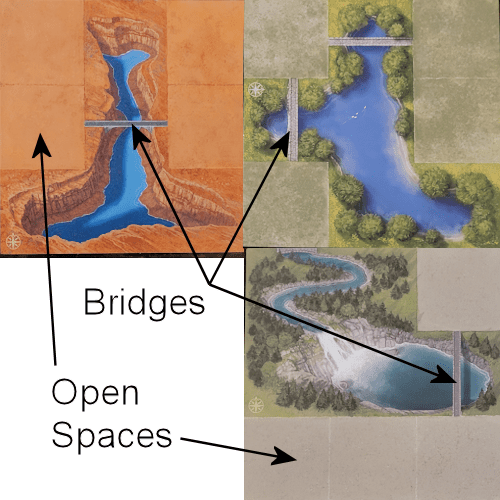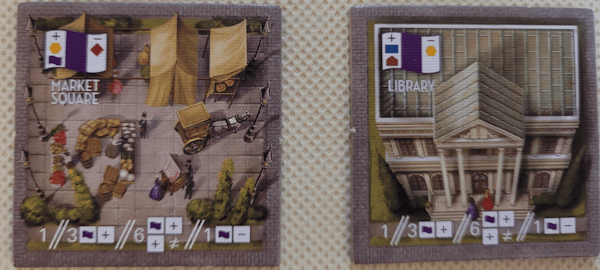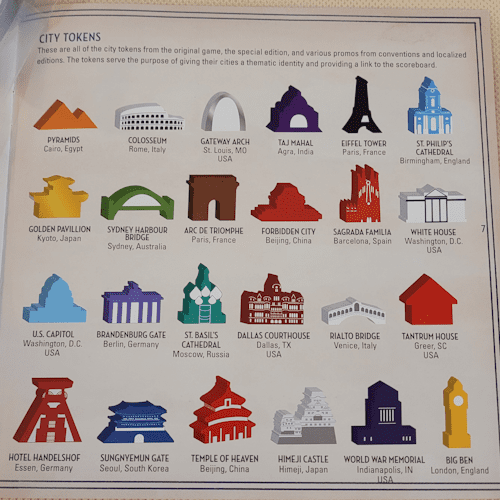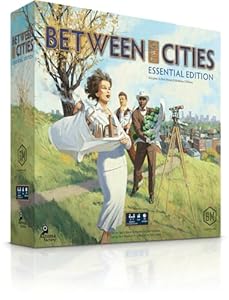Between Two Cities is a wonderful game that only gets better when you add the elements of the Capitals expansion. Since I have already covered gameplay in the initial review, this article will cover how the expansion adds to, and changes, the base game.
What’s in the Box?
Between Two Cities is an excellent game on its own. This means that my first question when I became aware of the expansion was: what can they add that would make this game more fun? My first thoughts were empty – I really could not think of much I would want to see added to the game.
The main issue was that the mix of the tiles in the base game was good. I mean really good. If you add in more of those tiles, then they would need to be in the same proportions as the base game, which means why bother? If you were to introduce a bunch of new types of tiles, then they would dilute the originals, making each type harder to accumulate and get good scores.
Nothing came to mind for me. Luckily, Stonemaier Games was not relying on me to come up with new ideas! This is what you get with the expansion:
- Landscape Mats
- Civic Building tiles
- District Cards and scoring tiles
- More of those beautiful City Tokens
Let’s take a closer look at each of these.
Landscape Mats
Of the additions that Capitals brings to the game, the Landscape Mats are the element that players will notice first. Each mat is a 3×3 grid with four open spaces (where tiles can be placed), and five terrain spaces (where tiles cannot be placed). The terrain ranges from mountains to rivers to lakes.
Each of these tiles also includes, within the terrain, one to three bridges. Bridges are like regular terrain in that you cannot place tiles there, but the two tiles on either side of the bridge are considered adjacent for purposes of scoring. In play, this creates some very interesting city design choices!

The original game limits the city to a 4×4 grid (i.e., no tile may be placed in such a way as to create a fifth row or column). With the addition of the terrain, the city is expanded from 16 to 25 spaces; a 5×5 grid. Five of these spaces will be terrain, leaving 20 spaces for city development. This is four spaces more than the original game; to accommodate this, players will be drawing nine tiles (instead of seven) in rounds one and three. This means that those rounds will have one additional placement phase, adding a total of four more tiles. More choices, more chances to score!
Note: in the base game, the Shops score for the length of a line of Shops in the city. Since the original game would have a limit of four shops in a line, the tiles only show a score up to that limit. The rules add a higher score for a line of five shops.
Civic Building tiles
Civic Buildings are special tiles representing public resources (e.g., a College, an Elementary School, a Monument, a Police Station, etc.). The expansion comes with 21 unique Civic Building tiles. Each Civic Building has three tile types listed; two positive and one negative. The idea is to place these tiles adjacent to tiles of the positive types, while avoiding placing them adjacent to tiles of the negative type. Depending upon how well you are able to do this, these tiles will score 1, 3, or 6 points each.

District Cards and Scoring Tiles
With the addition of Capitals, there are seven types of building tiles in Between Two Cities: Civic Building, Factory, House, Office, Park, Shop, and Tavern. The expansion comes with a set of District Cards – one card for each tile type. At the start of the game, the District Cards are shuffled and dealt out into three pairs; each pair represents a district that is scored at the end of the game, with one tile type not included.
With the exception of Factory + House (since you never want these buildings to be adjacent to one another), a district can be any two building types (e.g., Park + Tavern, Civic Building + House, Factory + Office, etc.). Each pairing is assigned to one of the three District Scoring Tiles. Each scoring tile has a gold and silver score shown. The gold score goes to the city that has the largest contiguous group of the two tile types for that district; silver goes to the city with the second largest grouping. There are some relatively simple rules for handling ties.

City Tokens
In the base game, there are seven pairs of City Tokens used as scoring markers. In my review of the base game, I mentioned that these are quite beautiful, and players will often reserve a City Token pair, much like how when we were children we would all want to be the “car” or the “horse” in Monopoly. Capitals adds seven more pairs of City Tokens.
At the back of the rules, there is an image of all of the City Tokens that have been produced for the game. In addition to the 14 pairs from the base game and expansion, there are ten more pairs that were produced. These were either a part of the special edition of the game, or the various promos. If you are like me, this is a scavenger hunt that you might spend months (or years) attempting to complete. I am not there yet, but I will be at some point!

Is It Worth It?
Does Capitals add enough fun to make purchasing it worth it? The short answer is yes.
The Landscape Mats give each city a unique shape and feel; the choice for where to place any tile not only has to take the basic scoring of that tile type into account, it has to take the terrain, the bridges, and the additional column and row available into account. All of these factors can have an impact on where to place the tile; add all of them together, and what you have is a series of choices that can be quite different depending upon the terrain you are using.
Each Civic Building tile encourages the placement of two tile types adjacent to it, while discouraging the placement of a third type. This can mean having to weigh the placement of a tile based on its basic scoring, or the Civic Building’s scoring. Every Civic Building is different, and so each one has to be looked at carefully – especially if two Civic Buildings are close enough to share spaces of adjacency!
Each time you play, a different mix of tile types will be paired and placed into the three districts; each district will encourage grouping in different ways, which can have a huge impact on how you place the tiles. This may seem a small thing at first, but with each play of the game, I have seen that this can have a significant impact on how a city is designed. It just becomes one more datapoint – one more factor to consider – when trying to maximize the score of each city.
The City Tokens do not change anything about the game as far as game play; but they add to the beauty of an already gorgeous game. They are art for the sake of art, and this is never a bad thing in my opinion.
So, yes! I highly recommend that if you like Between Two Cities, you add Capitals to the mix.
Of course, there is also the Essential Edition…
A Quick Note on the Essential Edition
Stonemaier Games has stopped selling the base game and the expansion separately. But fear not! They now have the Essential Edition. The Essential Edition has most of the components of the base game and Capitals. The following items are not included:
- The scoreboard is replaced with a scorepad. The scoreboard is not used until the very end of the game; replacing this is not a bad idea, really.
- There are only seven City Tokens (not seven pairs, just seven tokens). Since these tokens were originally used to identify the city with one token and that city’s score with the other (and since there is no longer a score board), there is no need for pairs of tokens. Still, this means that seven of the City Token designs that come with the two-box set are not represented in the Essential Edition.
If you are like me and you have the originals, there is no need to purchase the Essential Edition; you have everything. (I have a soft-spot for the City Tokens and so I would want to keep my originals no matter what).
If you were to go out today and get the Essential Edition, you won’t be missing anything from a functional standpoint. You will get a box that is a bit larger, so it can easily accommodate all of the components.












Thanks for the review. This expansion has been sitting unopened on my shelf for an embarrassingly long time now. Sounds like it’s about time to rectify that!
Yes it is! Let me know how you like it!